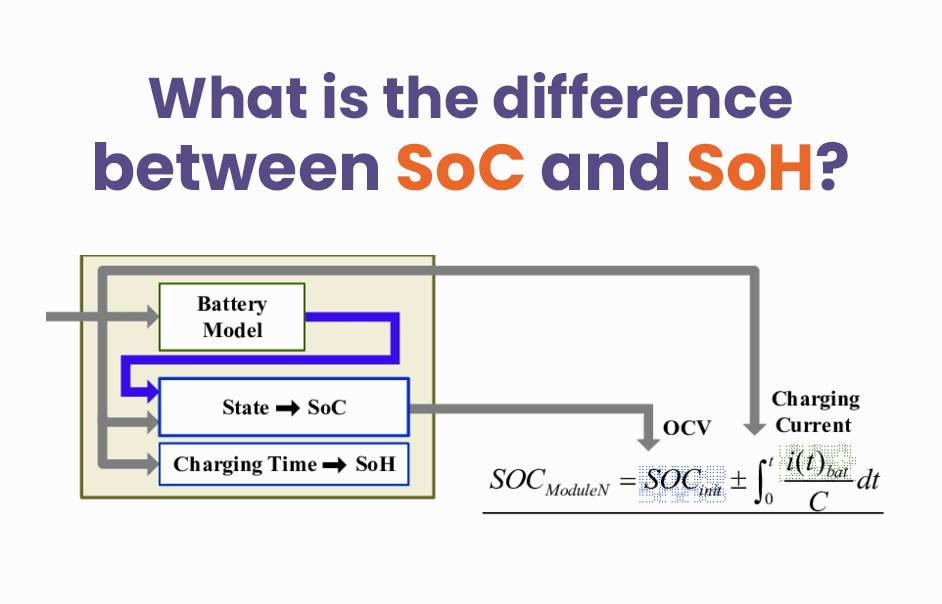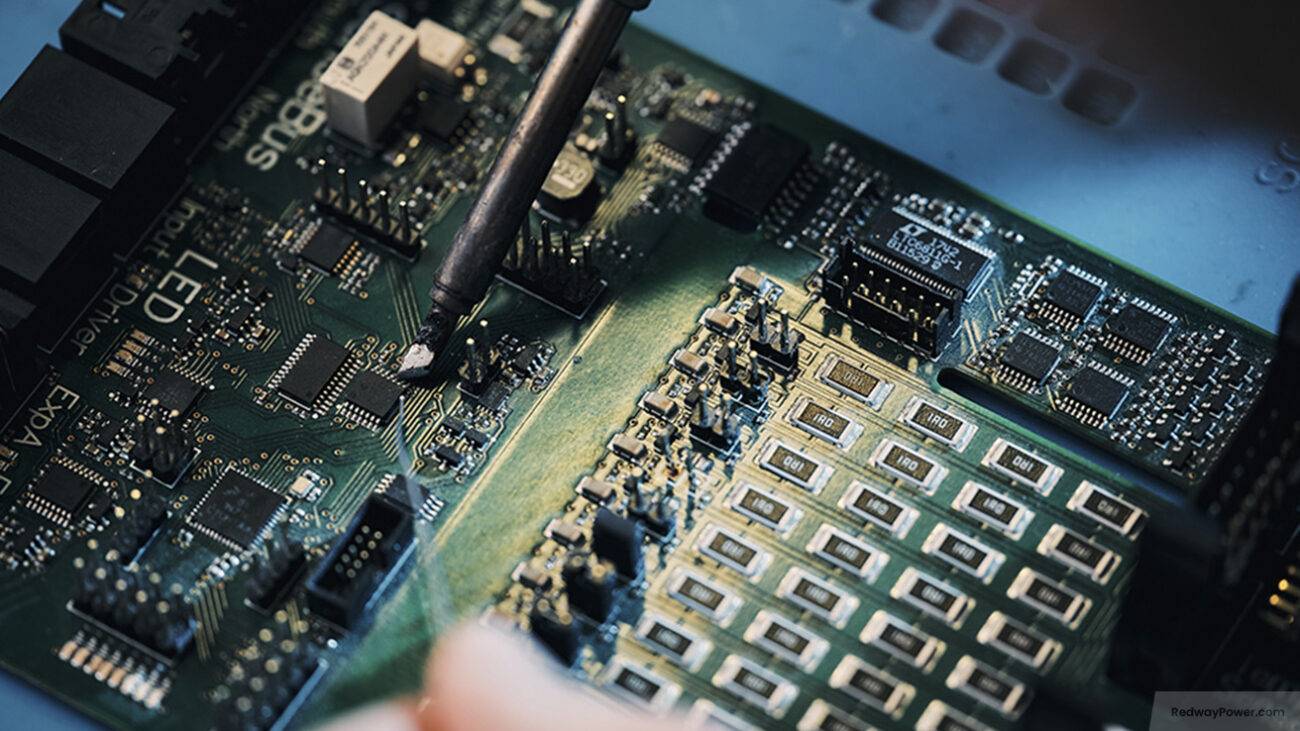Understanding SoC (State of Charge)
SoC, or State of Charge, is a crucial aspect in the battery world, akin to a fuel gauge in a car. It indicates the remaining energy in a battery, vital for users to manage device usage effectively.

- Understanding SoC:
- Definition: SoC represents the percentage of charge in a battery.
- Example: A smartphone at 50% SoC means half the capacity is used.
- Importance: Enables users to plan device usage and avoid sudden shutdowns.
- Monitoring and Display:
- Methods: Displayed as percentages or through graphical representations.
- Purpose: Provides visibility for users to plan and ensure sufficient power.
- Battery Lifespan:
- Optimal Range: Lithium-ion batteries perform best between 20-80% SoC.
- Impact: Charging beyond this range accelerates aging and reduces capacity.
- Best Practices: Avoid deep discharges and prevent constant charging post full capacity.
- Optimizing SoC for Longevity:
- Preventive Measures: Implement practices like avoiding deep discharges and unplugging post full charge.
- Goal: Prolong overall battery lifespan and maintain optimal performance.
Understanding and managing SoC is not only about immediate power awareness but also a strategy for ensuring sustained device satisfaction over the long term!
Understanding SoH (State of Health)
SoH, or State of Health, is a critical factor for evaluating a device’s battery condition and performance. Unlike SoC, which shows current energy levels, SoH reflects how well a battery retains its original capacity.
- SoH vs. SoC:
- Difference: SoH assesses long-term battery health, while SoC indicates current charge levels.
- Importance: SoH helps identify the need for replacement and addresses underlying issues affecting performance.
- Factors Leading to Degradation:
- Causes: Batteries degrade over time due to usage, temperature changes, and wear.
- Impact: Gradual reduction in maximum capacity and efficiency.
- Measurement: Manufacturers use algorithms analyzing charging cycles, voltage, and internal resistance.
- Maintenance and Longevity:
- Crucial Role: Maintaining good SoH prolongs battery life and ensures optimal performance.
- Preventive Steps: Regular monitoring helps address signs of degradation, preventing unexpected issues.
- Manufacturers’ Approach:
- Sophisticated Algorithms: Manufacturers use advanced algorithms to estimate capacity loss.
- Data Analysis: Monitoring charging cycles, voltage levels, and internal resistance over time.
- Conclusion:
- Essential Metrics: SoC provides real-time charge data, while SoH offers insight into long-term health.
- Combined Impact: Both metrics are vital for efficient device operation and maximizing lifespan.
Understanding and actively managing both SoC and SoH empower users to enjoy reliable performance and extend the overall lifespan of their devices!
Importance of monitoring SoC and SoH in devices
Understanding and monitoring the State of Charge (SoC) and State of Health (SoH) in electronic devices are crucial in today’s tech-centric world. These metrics significantly impact device performance and longevity.
- SoC Monitoring:
- Significance: Tracks remaining battery power for timely recharging.
- Benefits: Prevents unexpected shutdowns, ensuring device functionality when needed.
- SoH Monitoring:
- Insights: Provides early detection of battery health degradation.
- Importance: Identifies issues caused by usage patterns, temperature, and charging habits.
- Informed Decision-Making:
- Optimizing Usage: Informed adjustments based on SoC and SoH data.
- Proactive Approach: Prolongs battery life and enhances overall user experience.
- Empowering Users:
- Greater Control: Active monitoring empowers users to manage device performance.
- Longevity Assurance: Informed decisions contribute to prolonged device lifespan.
Understanding and actively managing SoC and SoH not only optimize device performance but also ensure a longer and more reliable life for our electronic companions!
The impact of SoC and SoH on battery life
Battery life hinges on two critical factors: State of Charge (SoC) and State of Health (SoH). SoC reflects current battery charge, while SoH gauges overall health and capacity.
- Optimizing SoC:
- Essential Role: Maintaining optimal charge levels is key for prolonged battery life.
- Risks: Consistent low or high charge levels can degrade the battery over time.
- Preserving SoH:
- Vital Monitoring: Ensuring good battery health requires monitoring and maintenance.
- Factors Contributing: Temperature, usage patterns, and charging habits impact SoH degradation.
- Impact on Battery Life:
- Consequences: Poor SoC or SoH leads to reduced runtimes, sudden shutdowns, or inefficient charging.
- Struggles: Diminished battery health may require more frequent recharging.
- Best Practices:
- Temperature Management: Avoid extremes during charging or discharging.
- Proper Charging Techniques: Follow manufacturer recommendations, preventing issues like overcharging.
- Calibration: Periodically calibrate the device’s battery meter for accurate readings.
- Prolonging Lifespan:
- Understanding Impact: Recognizing how SoC and SoH affect batteries is crucial.
- Taking Measures: Active monitoring and proper maintenance significantly extend device lifespan.
Understanding and managing both SoC and SoH, coupled with adopting best practices, ensures our devices perform reliably and enjoy a longer and healthier life.
Differences between SoC and SoH
Understanding the differences between State of Charge (SoC) and State of Health (SoH) is crucial for effective battery management. While both metrics relate to battery health, they serve distinct purposes in evaluating immediate charge levels and long-term battery health.
- SoC:
- Definition: Indicates the current energy level in a battery, akin to checking your phone’s battery percentage.
- Focus: Immediate charge status, telling when a recharge is needed.
- SoH:
- Definition: Reflects the overall condition and healthiness of a battery.
- Considerations: Accounts for capacity degradation, internal resistance increase, and aging effects.
- Focus: Provides insight into long-term durability and original capacity retention.
- Monitoring Significance:
- Immediate vs. Long-Term: SoC focuses on immediate charge levels, while SoH provides a broader view of battery health over time.
- Diagnostic Value: Both metrics are essential for diagnosing battery issues and optimizing device performance.
- Accurate Measurement:
- Tools/Software: Specialized tools or software are used by manufacturers or technicians for accurate measurement.
- Importance: Precise measurement aids in identifying and addressing battery issues effectively.
- Improvement Strategies:
- Smart Charging Practices: Implementing efficient charging habits.
- Temperature Management: Avoiding extreme conditions that accelerate battery degradation.
- Periodic Calibration: Ensuring accurate readings through device calibration.
- Summary:
- Key Difference: SoC measures immediate charge level, while SoH assesses long-term health.
- Essential Monitoring: Regular checks of both metrics optimize device performance.
- Accurate Measurement Tools: Specialized tools or software enhance precision.
- Improvement Strategies: Smart charging, temperature control, and periodic calibration contribute to overall battery health.
Remember, maintaining both SoC and SoH ensures your devices remain in top condition, delivering optimal performance and longevity.
How to measure and improve SoC and SoH
Measuring and improving the State of Charge (SoC) and State of Health (SoH) of your devices is crucial for optimal battery performance. Here are practical steps you can take:
- Measuring SoC:
- Tools/Software: Use battery monitoring tools or software for real-time information on your device’s current charge.
- Tracking Power Usage: Optimize power usage by reducing background processes, closing unused apps, adjusting screen brightness, and utilizing power-saving modes.
- Improving SoC:
- Power Usage Optimization: Reduce unnecessary processes, close unused apps, lower screen brightness, and disable unused features.
- Power-Saving Modes: Activate device power-saving modes to extend battery life.
- Measuring SoH:
- Advanced Tools/Professional Assistance: Use advanced diagnostics tools or seek professional assistance to assess overall battery health.
- Capacity Analysis: Measure battery capacity compared to its original design to determine health status.
- Improving SoH:
- Charging Habits: Avoid overcharging or fully draining; aim for regular partial charges within a safe range.
- Software Updates: Regularly update device software to benefit from manufacturer optimizations positively impacting SoC and SoH.
- Conclusion:
- Monitoring Crucial: Closely monitor SoC and SoH levels for device longevity.
- Proactive Maintenance: Take necessary steps to maintain both metrics, ensuring optimal performance and reliable battery life.
Remember, understanding and actively managing SoC and SoH contribute to maximizing device performance and ensuring long-lasting reliability from your devices’ batteries.



